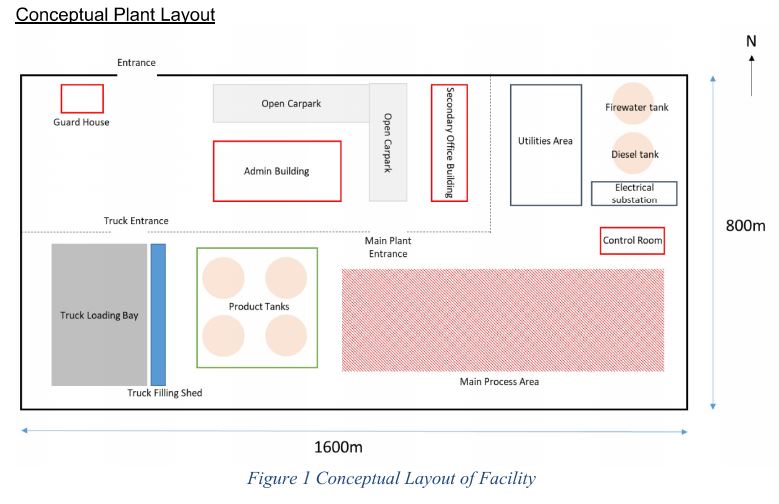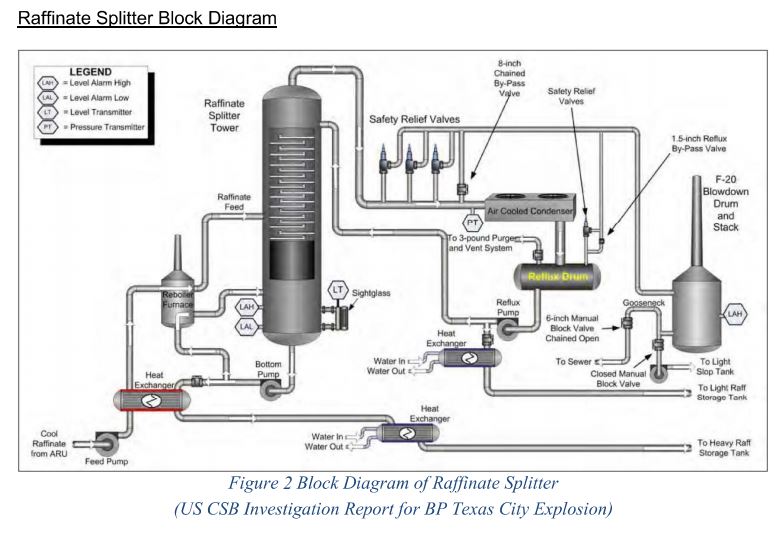Assignment Brief:
You are working in a risk consulting company. Your company is engaged by an oil company to carry out a risk assessment for the buildings in their new refinery, which will be built on Jurong Island, Singapore. As a safety engineer, you are appointed to lead the project. The client wanted to study the possible hazardous impact on the building and review what can be done to protect their workers in the buildings.
The project is a conceptual design phase. To kick-start the project, your client has provided you with some high-level information about the plant.
Process Description
The refinery consists of many process units and storage tanks. One of the main units is the isomerization unit, designed to convert straight-chain normal pentane and hexane into higher octane branched-chain isopentane and isohexane for gasoline blending and chemical feedstocks. The isomerization unit consists of 4 sections, one of which being a raffinate splitter shown in Figure 2.
The raffinate splitter section took raffinate, which is a non-aromatic, primarily straight-chain hydrocarbon mixture, and separate it into the light and heavy components. Approximately 40% of the raffinate feed was recovered as light raffinate, which is primarily pentane/hexane. The remaining raffinate was recovered as heavy raffinate, which was used as chemicals feedstock or blended into unleaded gasoline.
The process equipment in the raffinate splitter section consists of a feed surge drum; a distillation tower; a furnace with two heating sections, where one is used as a reboiler for heating the bottoms of the tower and the other for preheating the feed; a condenser and an overhead reflux drum; pumps and heat exchangers as shown in Figure 2.
The distillation tower is around 3.8m in diameter and 52m in height, with an approximate liquid full volume of 586,000 liters. Liquid raffinate feed was pumped into the raffinate splitter tower near the tower’s midpoint and an automatic flow control valve adjusted the feed rate. Heavy raffinate product will be taken off as a side stream at the discharge of the bottom pump and sent to storage. The flow of the side stream is controlled by a level control valve that maintains a constant level in the distillation tower. The splitter tower is equipped with a level transmitter, configured with a high-level alarm.
Light raffinate vapors flowed overhead and down a section of pipe before they are condensed and deposited into a reflux drum. Liquid from the reflux drum is pumped back into the tower. Light raffinate product is taken off as a side stream at the discharge of the reflux pump and sent to storage.
A set of three parallel safety relief valves are located at the overhead vapour line, and their outlet is piped to a disposal header collection system that discharged into a blowdown drum fitted with a vent stack. The set pressure of the relief valves was at 40, 41 and 42 psig. The operating pressure and temperature of the tower is around 36 psig and 130degC.


The client expects you to provide advice on the requirements below. You may state all assumptions used in the assessment.
- Discuss and provide advice to the client on the risk criteria for the occupied buildings. You may review industry practices, standards, publications, risk criteria from different jurisdictions, past incident reports, to justify the risk criteria adopted for this project.
- Review literatures and publications on occupied building risk assessment and propose all approaches to carry out the assessment for this new refinery. You should first identify all the occupied buildings at the site. Your proposal should compare all the possible methodologies for building siting and risk estimation of the occupied buildings. You should also include the detailed steps to carry out the assessment. The assessment shall be specific to the refinery process described above. State all assumptions you made in your assessment.
- Estimate the risk at the occupied buildings. Describe the methodology which you have adopted and state all assumptions you made in your calculation. You should also explain the rationale for the selection of the methodology.
- Discuss the possible risk reduction measures that can be implemented to reduce risk to workers in the occupied buildings. Demonstrate that risk has been reduced to As Low As Reasonably Practicable. You may explore all possible risk reduction measures as the project is still in the conceptual design phase.


